Scottish Health Survey 2016 - volume 1: main report
Statistics relating to the health of people living in Scotland.
4 Diet
Ian Montagu
Summary

- Average daily consumption of fruit and vegetables for adults reduced from 3.3 portions in 2008 to 3.0 portions in 2016.
- In 2016 adults mean consumption of fruit and vegetables was lowest for those aged 16-24 (2.5 portions) and highest among those aged 55-64 (3.3 portions).
- In 2016 more women (22%) ate the recommended 5-a-day portions of fruit and vegetables than men (17%).
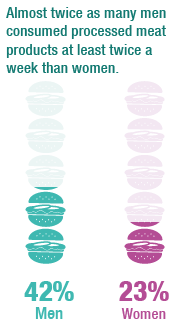
- In 2016, 13% of children aged 2-15 met the 5-a-day fruit and vegetables recommendations on the previous day, the proportion remaining relatively stable since 2008.
- In 2015/2016 the proportion of girls meeting the 5-a-day guideline at 15% was higher than boys at 11%.
- Consumption of non-diet soft drinks at least once a day amongst adults fell from 27% in 2014 to 20% in 2016.
- Biscuit consumption at least once a day for adults also decreased from 34% in 2008 to 28% in 2016.
- Around a third (32%) of adults ate oily fish in 2016, a significant increase from 25% in 2008 and 2014.
- The level of consumption of all foods and drinks high in fat and/or sugar tended to be higher among men.
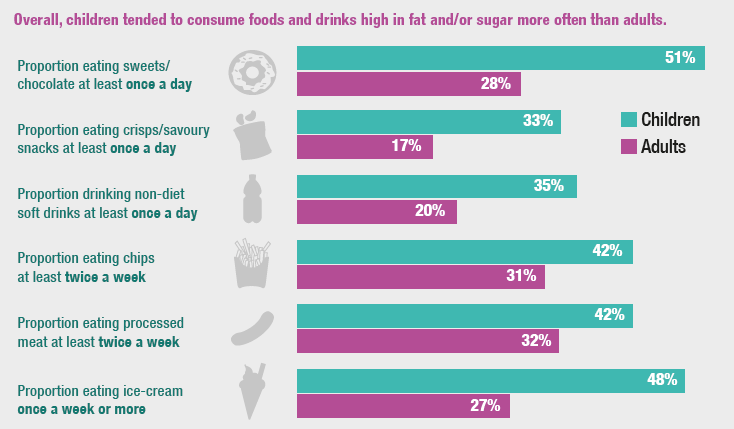
4.1 Introduction
According to the Global Nutrition Report, poor quality diet is the primary risk factor in the global burden of disease[1]. The risk of many non-communicable diseases, including cardiovascular disease, Type 2 diabetes and certain types of cancer is affected by the foods people consume. Estimates from international comparisons have suggested that around 30% of cases of cancer[2] and cardiovascular disease[3] worldwide could be prevented by changes in diet, both through improvements in nutritional content and reductions in body mass[4].
Early research on diet and chronic diseases focussed on the role of saturated fat, and fruit and vegetable intake considered together. However recent studies have shown that vegetable consumption is more important than fruit consumption in explaining reduced risks of certain types of breast cancer[5], stroke[6], and diabetes[7], while fruit consumption has been found to be more strongly associated with reduced risk of coronary heart disease in women[6] and oesophagal and stomach cancers[8].
Other aspects of diet, including the potentially positive effects of fibre and wholegrains[9], oily fish intake[10,11] and antioxidant vitamins[12] have been studied in relation to cardiovascular disease and cognitive decline in later life. Folates have been shown to have a role in the prevention of neural tube defects[13]; vitamin D and calcium are determinants of bone health[14]; sugar intake is associated wtih dental decay[15]; and salt intake is linked to the development of hypertension[16]. A link between consumption of red and processed meats in bowel disease has been proposed[17,18] while it has been suggested that free sugars may have a particular role in the development of obesity and Type 2 diabetes[19]. Sugary drinks have been identified as the key contributor to total sugar intake in children aged 11-18 years and a source of empty calories[20]. Combined effects of different foods in healthy dietary patterns such as the Mediterranean Diet have been shown to be associated with brain changes in later life[21].
Given the broad range of health conditions which may be influenced by diet it is difficult to estimate the economic and social costs of poor eating habits, but some examples can highlight the potential benefits of improving the diet of the population. Treatment of cardiovascular disease, including hypertension, and Type 2 diabetes, represent significant costs to the NHS, as do treatment of dental decay in children and bone disease in adults. Evidence on the economic costs of risk factors for chronic disease suggests that poor diet is a greater burden on the NHS than smoking, alcohol consumption, overweight and obesity or physical inactivity[22].
Surveys of household food intake and of children’s diet in Scotland in 2006 and 2010 have highlighted socio-economic inequalities in consumption of a wide range of food groups such as fruit and vegetables and soft drinks. However, differences in the fat and sugar content of the diet between those in more versus less deprived areas are not marked[23,24,25,26].
4.1.1 Policy background
Poor diet is a long-standing challenge to improving health in Scotland. The high level of intake of energy-dense foods high in fat, sugar and salt is a particular problem with wide-ranging consequences for the health of the population[27]. In response to this, a healthy eating culture and access to affordable, fresh and nutritious food is a national priority for the Scottish Government in its aim to become a Good Food Nation[28].
The Scottish Dietary Goals[29] replaced the previous Scottish Dietary Targets in 2013 and were revised in 2016[29]. The revised goals include:
- The World Health Organisation 5-a-day recommendation for adults (to consume at least five varied 80g portions of fruit and vegetables per day).
- To reduce salt intake from around 9g to 6g per day for adults.
- To reduce average calorie intake by 120 kcal per day and average intake of red meat to 70g per day.
- To provide advice on limiting fat and sugar intake and increasing consumption of fibre and oil-rich fish.
- To reduce the average intake of free sugars to 5% of total dietary energy.
- To increase intake of dietary fibre to 30g per day for adults.
- To maintain intakes of starchy carbohydrates at 50% of total dietary energy.
Existing UK healthy eating advice was updated as the Eatwell Guide in 2016 to illustrate the proportions and types of foods from major food groups which would make up a healthy diet[30]. Following recommendations from the Scientific Advisory Committee on Nutrition (SACN), Scottish Government advice on vitamin D for all age groups has also been updated[31]. The Scottish Government is funding a number of programmes aimed at encouraging people to make healthier choices in the way they shop, cook and eat, through its Eat Better Feel Better campaign[32].
The Scottish Government will be consulting with stakeholders later this year in order to develop a new Diet and Obesity Strategy, which will include a range of actions to deliver a new approach to diet and healthy weight management. The recently published Programme for Government 2017-18 also sets out the Scottish Government’s intention to progress measures limiting the marketing of products high in fat, sugar and salt[33].
Food in schools has been the main focus of improving the poor diet of children in Scotland. The Schools Food and Nutrition legislation introduced in 2007 states the responsibilities of local authorities to ensure that schools provide food and drink of an appropriate nutritional standard[34]. At the same time, the Scottish Government published Healthy Eating in Schools, a guide to implementing the legislation[35]. The foods available to children who leave school at lunchtimes have also been considered in the Beyond the School Gate advice to caterers in the vicinity of schools[36]. The Scottish Government developed the Better Eating Better Learning guidance in 2014 which provided refreshed guidance to a range of stakeholders (schools, local authorities, caterers, procurement departments, parents, children and young people) to support them to work in partnership to make further improvements in school food and food education[37].
A key part of the Health Promoting Health Service is a focus towards the provision of healthier food choices in hospitals. All NHS-run restaurants for staff, visitors and patients now have the Healthyliving Award Plus as a mandatory requirement with all voluntary sector establishments holding the award. The Healthcare Retail Standard is being implemented in 2016-17 to ensure that any retail outlet in healthcare grounds provides a range of food items that are not high in fat, salt and sugar and that only foods which should be consumed more often or in greater amounts, e.g. fruit and vegetables, are promoted[38].
Specific measures which could be taken by retailers, manufacturers and caterers which would affect the wider population are outlined in the Scottish Government's Supporting Healthy Choices framework[39]. This is a voluntary framework based on four core principles. These are to:
- Put the health of children first in food-related decisions.
- Rebalance promotional activities.
- Support consumers and communities.
- Formulate healthier products.
Building on these existing policies and programmes, the Scottish Food Commission was convened recently to provide evidence-informed advice on approaches that will contribute most to making Scotland a Good Food nation and address the challenges of Scotland’s food culture.
In 2016 the UK Government proposed a soft drinks industry levy to be paid across the UK by producers and importers of soft drinks that contain added sugar with effect from April 2018. A public consultation on the proposed levy was undertaken later in the year[41] showing overwhelming support from medical and health based organisations and mainly opposition from manufacturers and trade bodies. Draft legislation was published at the end of 2016[42] and secondary legislation is due in 2017.
4.1.2 Reporting on diet in the Scottish Health Survey (SHeS)
This chapter provides information on fruit and vegetable consumption among adults and children from 2003 to 2016. Information on other adult and child eating habits are also provided.
Supplementary tables on diet, including analysis by socio-economic classification, household income and area deprivation are also published on the Scottish Health Survey website[43].
4.2 Methods And Definitions
4.2.1 Measuring fruit and vegetable consumption
The module of questions on fruit and vegetable consumption was designed with the aim of providing sufficient detail to monitor population-level adherence to the 5-a-day recommendation. These questions have been asked of all adults (aged 16 and over) participating in the survey since 2003 and of children aged 2 to 15 since 2008.
The module includes questions on consumption of the following food types in the 24 hours to midnight preceding the interview:
- vegetables (fresh, frozen or canned);
- salads;
- pulses;
- vegetables in composites (e.g. vegetable chilli);
- fruit (fresh, frozen or canned);
- dried fruit;
- fruit in composites (e.g. apple pie);
- fresh fruit juice.
A portion is defined as the conventional 80g of a fruit or vegetable. Since 80g is difficult to visualise, survey respondents were asked to describe the amount of each fruit or vegetable they consumed using more everyday terms, such as tablespoons, cereal bowls and slices. These everyday measures were then converted to 80g portions prior to analysis. Examples are given in the questionnaire to aid the recall process, for instance, tablespoons of vegetables, cereal bowls full of salad, pieces of medium sized fruit (e.g. apples) or handfuls of small fruits (e.g. raspberries). In spite of this, there may be some variation between participants’ interpretation of how much they consumed. The following table shows the definitions of the portion sizes used for each food item included in the survey:
| Food item | Portion size |
| Vegetables (fresh, frozen or canned) | 3 tablespoons |
| Pulses (dried) | 3 tablespoons |
| Salad | 1 cereal bowlful |
| Vegetables in composites, such as vegetable chilli | 3 tablespoons |
| Very large fruit, such as melon | 1 average slice |
| Large fruit, such as grapefruit | Half a fruit |
| Medium fruit, such as apples | 1 fruit |
| Small fruit, such as plums | 2 fruits |
| Very small fruit, such as blackberries | 2 average handfuls |
| Dried fruit | 1 tablespoon |
| Fruit in composites, such as stewed fruit in apple pie | 3 tablespoons |
| Frozen fruit/canned fruit | 3 tablespoons |
| Fruit juice | 1 small glass (150 ml) |
Since the 5-a-day recommendation stresses both volume and variety, the number of portions of fruit juice, pulses and dried fruit is capped so that no more than one portion of each can contribute to the total number of portions consumed. Interviewers record full or half portions, but nothing smaller.
4.3 Fruit And Vegetable Consumption
4.3.1 Trends in adult fruit and vegetable consumption since 2003
Adults consumed a mean of 3.0 portions of fruit and vegetables per day in 2016. This mean level of adult fruit and vegetable consumption was the lowest recorded in the time series, with mean consumption among adults having previously ranged between 3.1-3.3.
In 2016, 20% (one fifth) of adults consumed the recommended five portions of fruit and vegetables on the previous day. This represents a significant decrease from 23% in 2009. It is the joint-lowest recorded proportion of adults meeting the 5-a-day guidelines in the time series (with 20% consuming 5 portions or more also found in 2012 and 2014). In 2016, the proportion of adults eating no fruit or vegetables on the previous day was the highest in the time series (12%), with levels having fluctuated between 9-11% in previous years.
At 3.2 portions a day, mean fruit and vegetable consumption among women in 2016 was 0.4 portions a day higher than among men (2.8 portions a day). This is the largest observed difference in mean fruit and vegetable consumption between men and women in the time series. In previous years, mean fruit and vegetable consumption among men has been measured at between 0.1 and 0.3 portions a day lower than among women.
The levels of women and men eating at least five portions of fruit and vegetables on the previous day in 2016 were significantly different. In 2016 the proportion of men meeting the 5-a-day guidelines on the previous day was 17%, the lowest in the time series, with levels fluctuating between 19% and 22% in previous survey years. The number of women eating at least the recommended five portions of fruit and vegetables on the previous day in 2016 was 22%, having ranged between 20% and 25% since 2003.
In 2016, 14% of men ate no fruit or vegetables on the previous day (the highest level in the time series) compared with 9% of women.
4.3.2 Adult fruit and vegetable consumption in 2016, by age and sex
As in previous survey years, mean daily fruit and vegetable consumption in 2016 was lowest for those aged 16-24 (2.5 portions) and highest among those aged 55-64 (3.3 portions).
In 2016, those aged 16-24 and those aged 65 and over were least likely to have consumed at least five portions of fruit and vegetables on the previous day (17% and 15-14% respectively). Those aged 16-24 were more likely to have eaten no fruit or vegetables on the previous day than any other adult age group. The proportion of those aged 16-24 having eaten no fruit or vegetables on the previous day increased from 18% in 2015 to 22% in 2016.
The proportion of women not having eaten any fruit or vegetables on the previous day in 2016 was highest for those aged 16-24 (17%) and lowest for those aged 35-44 (6%) and 55 and over (7%). Of women aged between 16 and 64, 22-25% ate the recommended five portions of fruit and vegetables on the previous day, compared with 13% of women aged 75 and over.
The proportion of men not having eaten any fruit or vegetables on the previous day in 2016 was highest for those aged 16-24 (27%) and lowest for those aged 65 and over (7-8%). Men aged 16-24 were also least likely to have eaten five portions of fruit and vegetables on the previous day (11%). This compared with 21% in the age groups most likely to have met the 5-a-day guidelines (those aged 25-34 and 55-64).
Figure 4A, Table 4.2
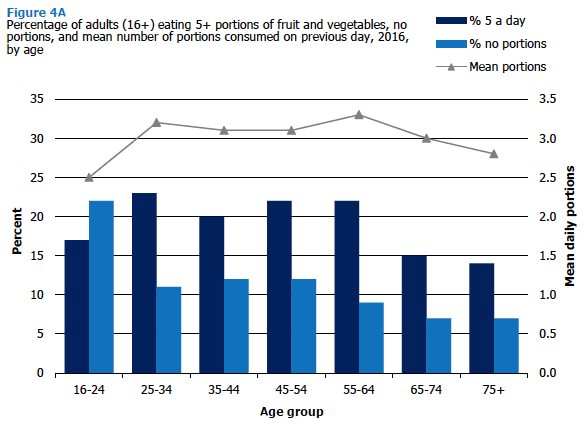
4.3.3 Trends in child fruit and vegetable consumption since 2003, 2008
Mean daily fruit and vegetable consumption among children aged 2-15 in 2016 was measured at 2.8 portions. Since the beginning of the time series in 2008 there has been little change in this level, measured at between 2.6 and 2.8 portions. Similar patterns were seen for 5-15 year olds in a time series that extends back to 2003.
There was no significant difference between girls and boys average consumption of fruit and vegetable portions per day. In 2016 boys aged 2-15 consumed a mean of 2.7 portions of fruit and vegetables per day, whilst girls consumed a mean of 2.9 portions. Mean fruit and vegetable consumption has ranged between 2.5 and 2.7 portions for boys aged 2-15, and between 2.7 and 2.9 portions for girls aged 2-15 since the start of the time series in 2008.
In 2016, of those aged 2-15, 13% ate the recommended five portions of fruit and vegetables on the previous day. The proportion of those aged 2-15 meeting the 5-a-day guidelines has fluctuated between 12-15% since the start of the time series in 2008.
In 2016, 9% of those aged 2-15 ate no fruit or vegetables on the previous day with levels fluctuating between 7% and 11% in previous years.
4.3.4 Child fruit and vegetable consumption, by age and sex for 2015/2016 combined
There were significant differences in the proportion of children meeting the 5-a-day guidelines on the previous day by sex, with 15% of girls and 11% of boys meeting the guideline. There was no clear pattern by age group (ranging between 11% and 15%).
However, there was a pattern by age group for the percentage of children eating no fruit or vegetables the previous day. Those aged 13-15 and 11-12 were most likely to have eaten no fruit or vegetables on the previous day (at 12%) and the percentage fell as age decreased. Among children aged 2-4 a comparatively low 4% had eaten no fruit or vegetables the previous day. There was no significant difference between the proportions of boys and girls who had eaten no fruit or vegetables on the previous day.
Figure 4B, Table 4.4
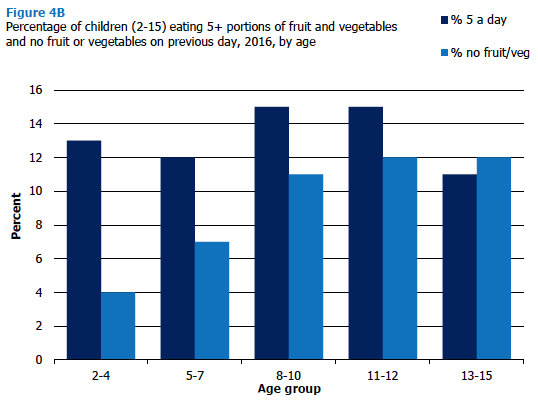
4.4 Consumption Of Other Foods In Adults, 2008-2016
4.4.1 Meat and fish
Of all adults, 57% consumed red meat at least twice a week in 2016. This represents a fall in red meat consumption from 2008, when 61% of adults ate red meat at least twice a week. This decline has been largely driven by women, 51% of whom consumed red meat at least twice a week in 2016 compared with 59% in 2008. In contrast, the number of men consuming red meat at least twice a week is identical to that in 2008 (64%).
Around one third of all adults (32%) consumed processed meat products (such as pies or sausages) at least twice a week in 2016, with no significant change since 2008 (28%). Almost twice as many men consumed processed meat products at least twice a week than women (42% of men compared with 23% of women).
Around half of adults (49%) ate white fish at least once a week in 2016, while just over a quarter (28%) ate tuna fish at least once a week. These figures have not changed significantly since 2008. However, around a third of adults (32%) ate oily fish, such as salmon or mackerel, at least once a week in 2016, a significant increase from previous survey years where the highest level was 26% in 2012.
A higher proportion of women than men ate tuna fish at least once a week (31% of women, 25% of men), however the proportion of men and women eating white fish (48% of women, 51% of men) and oily fish (32% of women, 32% of men) once a week in 2016 was broadly similar.
Figure 4C, Table 4.5
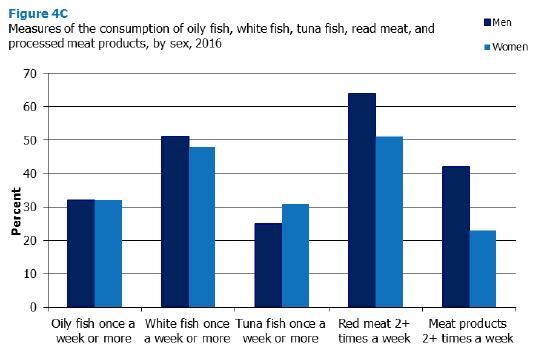
4.4.2 Milk
In 2016, 72% of adults consumed skimmed or semi-skimmed milk in drinks or on breakfast cereal (as opposed to whole milk, other types of milk or no milk); remaining relatively stable since the start of the series.
There was no significant difference between proportions of men and women who had consumed either skimmed or semi-skimmed milk in drinks or on breakfast cereal in 2016.
4.4.3 Foods rich in starch and fibre
In 2016, 50% of adults ate potatoes, pasta or rice at least five times a week. Just under a third of adults (28%) ate high fibre and low sugar cereal at least five times a week. The proportion of adults eating at least 2-3 slices of high fibre bread a day was significantly less in 2016 (at 38%) than in 2008 (at 42%). There has been no significant change in potato, pasta or rice consumption at least 5 times a week or high fibre and low sugar cereal consumption at least 5 times a week since 2008.
As in 2014, a larger proportion of men than women ate high fibre bread every day in 2016 (42% of men compared with 34% of women).
4.4.4 Foods and drinks high in fat and / or sugar
In 2016, 31% of adults consumed chips at least twice a week; 32% of adults ate cakes at least twice a week; 27% ate ice cream at least once a week; 28% of adults consumed sweets or chocolates at least once a day; 28% consumed biscuits at least once a day; and 17% consumed crisps or other savoury snacks at least once a day.
There has been a significant drop in the consumption of non-diet soft drinks amongst adults from 27% in 2014 to 20% in 2016. There has also been a downward trend in biscuit consumption once a day or more from 34% in 2008 to 28% in 2016. The consumption of other foods that are high in fat and / or sugar, or both, has not changed significantly since 2008.
The frequency of consumption of all foods and drinks high in fat and / or sugar was higher among men than women (with the exception of cakes for which consumption which was similar in men and women). The largest difference in consumption habits between men and women was observed in relation to chips, with 37% of men eating chips more than once a week compared with 26% of women.
Figure 4D, Table 4.5
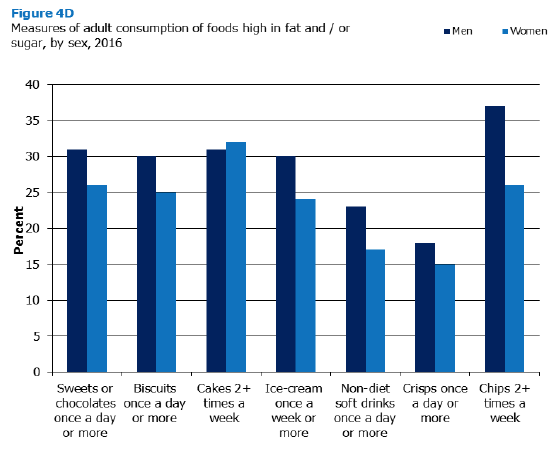
4.5 Consumption Of Other Foods In Children
4.5.1 Meat and fish
The same proportion of children consumed red meat at least twice a week in 2015/2016 as adults (57%) in 2016. There was no significant difference in the proportion of girls and boys eating red meat at least twice a week in 2015/2016.
Consumption of processed meat products, such as pies or sausages, at least twice a week was higher amongst children (42%) in 2015/2016 than amongst adults (32%) in 2016. In 2015/2016 more boys consumed processed meat products at least twice a week than girls (47% of boys compared with 36% of girls).
Just over a quarter of children (27%) ate tuna fish at least once a week in 2015/16, while around half (51%) ate white fish at least once a week. These figures are similar to those measured among adults in 2016. However, significantly fewer children in 2015/2016 than adults in 2016 ate oily fish, such as salmon and mackerel, at least once a week (16% of children compared with 32% of adults). Tuna fish was consumed more frequently by girls (29%) than boys (25%). There were no other significant differences between boys and girls in the consumption of fish.
4.5.2 Milk
In 2015/2016, 58% of children consumed skimmed or semi-skimmed milk in drinks or on breakfast cereal (as opposed to whole milk, other types of milk or no milk). A slightly higher proportion of girls than boys consumed either skimmed or semi-skimmed milk in drinks or on breakfast cereal in 2015/2016 (60% of girls compared with 55% of boys).
4.5.3 Foods rich in starch and fibre
In 2015/16, 32% of all children ate at least 2-3 slices of high fibre bread a day. In 2015/16, half of all children (50%) ate potatoes, pasta or rice at least five times a week, whilst 29% of children ate high fibre and low sugar cereal at least five times a week. These proportions were similar to those measured among adults in 2016.
A larger proportion of boys than girls ate high fibre bread every day in 2015/16 (35% of boys compared with 29% of girls). The proportions of boys and girls eating potatoes, pasta or rice at least five times a week were broadly similar (49% for boys and 50% for girls). High fibre and low sugar cereal 5-6 times a week were also similar among girls and boys (30% for boys and 27% for girls).
4.5.4 Foods and drinks high in fat and / or sugar
In 2015/16, 42% of children consumed chips at least twice a week (compared with 31% of adults in 2016); 33% of children ate cakes at least twice a week; 48% ate ice cream at least once a week (compared with 27% of adults in 2016); 51% of children consumed sweets or chocolates at least once a day (compared with 28% of adults in 2016); 32% consumed biscuits at least once a day; 33% consumed crisps or other savoury snacks at least once a day (compared with 17% of adults in 2016); and 35% drank non-diet soft drinks at least once a day (compared with 20% of adults in 2016). The frequency of consumption of foods high in fat and / or sugar was similar among boys and girls with the exception of biscuits once a day or more, where consumption for boys was higher (34%) than for girls (30%).
Contact
Email: Julie Landsberg, Julie Landsberg
Phone: 0300 244 4000 – Central Enquiry Unit
The Scottish Government
St Andrew's House
Regent Road
Edinburgh
EH1 3DG
There is a problem
Thanks for your feedback
